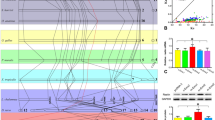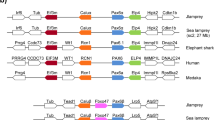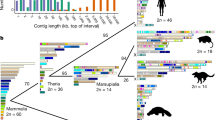Abstract
The structures of the genes coding for the opioid peptide precursors proopiomelanocortin, proenkephalin (proenkephalin A) and prodynorphin (proenkephalin B), are known for some mammalian species1–7. To gain insight into the evolutionary history of these precursors, we have examined the proenkephalin gene in the South African clawed toad, Xenopus laevis, which diverged from the principal line of vertebrate evolution some 350 Myr ago. The human proenkephalin gene consists of four exons, of which the main exon (exon IV) contains all known biologically active peptides—six Met-enkephalin sequences and one Leu-enkephalin sequence5,6. We report here the primary structures of the putative main exons of two proenkephalin genes in X. laevis, each of which codes for seven Met-enkephalin sequences but no Leu-enkephalin, indicating that Met-enkephalin preceded Leu-enkephalin in the evolution of the proenkephalin gene. The organization of the main exons of the toad genes is remarkably similar to that of the human gene and conserved regions provide evidence for functionally significant structures. We also detect a polymorphism in one of the toad proenkephalin genes, mapping 1.5 kilobases (kb) 5′ of the main exon; it is caused by an insertion/deletion of a 1-kb repetitive sequence which has the characteristics of a transposable element.
This is a preview of subscription content, access via your institution
Access options
Subscribe to this journal
Receive 51 print issues and online access
$199.00 per year
only $3.90 per issue
Buy this article
- Purchase on Springer Link
- Instant access to full article PDF
Prices may be subject to local taxes which are calculated during checkout
Similar content being viewed by others
References
Nakanishi, S. et al. Eur. J. Biochem. 115, 429–438 (1981).
Cochet, M., Chang, A. C. Y. & Cohen, S. N. Nature 297, 335–339 (1982).
Whitfeld, P. L., Seeburg, P. H. & Shine, J. DNA 1, 133–143 (1982).
Notake, M. et al. FEBS Lett. 156, 67–71 (1983).
Noda, M. et al. Nature 297, 431–434 (1982).
Comb, M., Rosen, H., Seeburg, P. H., Adelman, J. & Herbert, E. DNA 2, 213–229 (1983).
Horikawa, S. et al. Nature 306, 611–614 (1983).
Mount, S. M. Nucleic Acids Res. 10, 459–472 (1982).
Proudfoot, N. J. & Brownlee, G. G. Nature 263, 211–214 (1976).
Kilpatrick, D. L. et al. Proc. natn. Acad. Sci. U.S.A. 78, 3265–3268 (1981).
Kilpatrick, D. L., Howells, R. D., Lahm, H. W. & Udenfriend, S. Proc. natn. Acad. Sci. U.S.A. 80, 5772–5775 (1983).
Van Ooyen, A. van den Berg, J., Mantel, N. & Weismann, C. Science 206, 337–344 (1979).
Ordahl, C. P. & Cooper, T. A. Nature 303, 348–349 (1983).
Widmer, H. J., Andres, A.C., Niessing, J., Hosbach, H. A. & Weber, R. Devl Biol. 88, 325–332 (1981).
May, F. E. B., Westley, B. R., Wyler, T. & Weber, R. J. molec. Biol. 168, 229–249 (1983).
Germond, J. E. et al. Nucleic Acids Res. 11, 2979–2997 (1983).
Bisbee, C. A. Baker, M. A., Wilson, A. C., Hadji-Azimi, I. & Fischberg, M. Science 195, 785–787 (1977).
Thiébaud, C. H. & Fischberg, M. Chromosoma 59, 253–257 (1977).
Kleckner, N. A. Rev. Genet. 15, 341–404 (1981).
Galli, G., Hofstetter, H. & Birnstiel, M. L. Nature 294, 626–631 (1981).
Traboni, C., Ciliberto, G. & Corteso, R. EMBO J. 1, 415–420 (1982).
Kay, B. K. & Dawid, I. B. J. molec. Biol. 170, 583–596 (1983).
Davidson, E. H. & Britten, R. J. Science 204, 1052–1059 (1979).
Weinstock, R., Sweet, R., Weiss, M., Cedar, H. & Axel, R. Proc. natn. Acad. Sci. U.S.A. 75, 1299–1303 (1978).
Sanger, F., Nickleu, S. & Coulson, A. R. Proc. natn. Acad. Sci. U.S.A. 74, 5463–5467 (1977).
Comb, M., Seeburg, P. H., Adelman, J., Eiden, L. & Herbert, E. Nature 295, 663–666 (1982).
Noda, M. et al. Nature 295, 202–206 (1982).
Southern, E. M. J. molec. Biol. 98, 503–517 (1975).
Author information
Authors and Affiliations
Rights and permissions
About this article
Cite this article
Martens, G., Herbert, E. Polymorphism and absence of Leu-enkephalin sequences in proenkephalin genes in Xenopus laevis. Nature 310, 251–254 (1984). https://doi.org/10.1038/310251a0
Received:
Accepted:
Issue Date:
DOI: https://doi.org/10.1038/310251a0
This article is cited by
-
Regulated Proenkephalin Expression in Human Skin and Cultured Skin Cells
Journal of Investigative Dermatology (2011)
-
Characterization of repetitive DNA transcripts isolated from a Xenopus laevis gastrula-stage cDNA clone bank
Roux's Archives of Developmental Biology (1987)
-
Restriction fragment length polymorphisms and genetic improvement of agricultural species
Euphytica (1986)
Comments
By submitting a comment you agree to abide by our Terms and Community Guidelines. If you find something abusive or that does not comply with our terms or guidelines please flag it as inappropriate.



